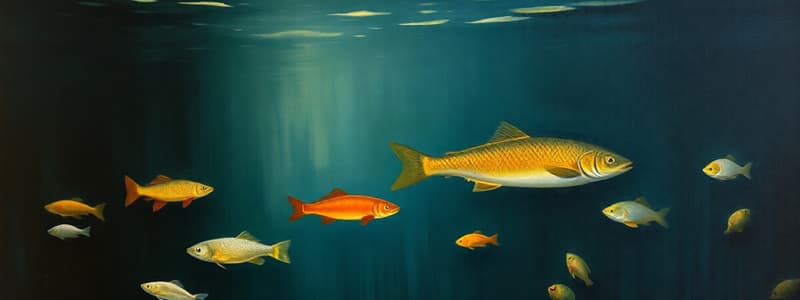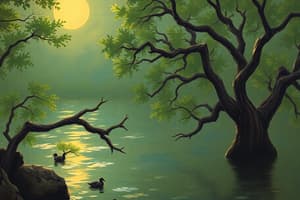Podcast
Questions and Answers
In a food web, energy transfer between trophic levels is often described by the 10% rule. If producers in an ecosystem contain 10,000 kilojoules of energy, approximately how much energy would be available to secondary consumers?
In a food web, energy transfer between trophic levels is often described by the 10% rule. If producers in an ecosystem contain 10,000 kilojoules of energy, approximately how much energy would be available to secondary consumers?
- 10 kilojoules
- 100 kilojoules (correct)
- 10,000 kilojoules
- 1,000 kilojoules
An organism that feeds on both primary consumers and producers would be classified as a:
An organism that feeds on both primary consumers and producers would be classified as a:
- Primary consumer
- Omnivore (correct)
- Secondary consumer
- Herbivore
Which of the following best explains why food webs are a more accurate representation of energy flow in an ecosystem than food chains?
Which of the following best explains why food webs are a more accurate representation of energy flow in an ecosystem than food chains?
- Food chains account for the 10% energy transfer rule, while food webs do not.
- Food chains include decomposers, whereas food webs focus only on consumers.
- Food webs only show a single, linear path of energy.
- Food webs illustrate the interconnected feeding relationships within an ecosystem. (correct)
Consider an ecosystem where snakes eat frogs, frogs eat grasshoppers, and grasshoppers eat grass. If the snakes are removed from this ecosystem, what is the most likely direct impact?
Consider an ecosystem where snakes eat frogs, frogs eat grasshoppers, and grasshoppers eat grass. If the snakes are removed from this ecosystem, what is the most likely direct impact?
In a trophic pyramid, which level contains the greatest total amount of energy?
In a trophic pyramid, which level contains the greatest total amount of energy?
An organism is classified as a carnivore. Based on this information, at which trophic level(s) could it potentially feed?
An organism is classified as a carnivore. Based on this information, at which trophic level(s) could it potentially feed?
Which of the following is an example of a producer that forms the base of the trophic pyramid in aquatic ecosystems?
Which of the following is an example of a producer that forms the base of the trophic pyramid in aquatic ecosystems?
In a terrestrial food chain consisting of grass, plant-eating insects, meat-eating insects, frog, snake, and bird of prey, what would happen if the meat-eating insect population drastically declined due to a disease?
In a terrestrial food chain consisting of grass, plant-eating insects, meat-eating insects, frog, snake, and bird of prey, what would happen if the meat-eating insect population drastically declined due to a disease?
In a marine food chain, how would a significant decrease in the crustacean population affect the other organisms?
In a marine food chain, how would a significant decrease in the crustacean population affect the other organisms?
In a freshwater lake ecosystem, if the bluegill population suddenly declined, which of the following would most likely occur?
In a freshwater lake ecosystem, if the bluegill population suddenly declined, which of the following would most likely occur?
In a simple food chain of grass → grasshopper → frog → snake → hawk, which organism represents the third trophic level?
In a simple food chain of grass → grasshopper → frog → snake → hawk, which organism represents the third trophic level?
Which of the following statements accurately describes the flow of energy in an ecosystem?
Which of the following statements accurately describes the flow of energy in an ecosystem?
What is the primary role of producers in an ecosystem's food chain?
What is the primary role of producers in an ecosystem's food chain?
If a pollutant that inhibits photosynthesis is introduced into the freshwater lake ecosystem, what would be the most likely initial consequence?
If a pollutant that inhibits photosynthesis is introduced into the freshwater lake ecosystem, what would be the most likely initial consequence?
How do trophic levels help classify organisms within an ecosystem?
How do trophic levels help classify organisms within an ecosystem?
Flashcards
Ecosystem
Ecosystem
Complex system of living things and their interactions in a specific area.
Food Chain
Food Chain
A pathway that represents who eats whom in an ecosystem.
Energy Flow
Energy Flow
Energy moves from one organism to another through feeding relationships.
One-Way Energy Flow
One-Way Energy Flow
Signup and view all the flashcards
Trophic Levels
Trophic Levels
Signup and view all the flashcards
Trophic Level Classification
Trophic Level Classification
Signup and view all the flashcards
Producers
Producers
Signup and view all the flashcards
Consumers
Consumers
Signup and view all the flashcards
Producers (Autotrophs)
Producers (Autotrophs)
Signup and view all the flashcards
Primary Consumers (Herbivores)
Primary Consumers (Herbivores)
Signup and view all the flashcards
Secondary Consumers
Secondary Consumers
Signup and view all the flashcards
Tertiary Consumers
Tertiary Consumers
Signup and view all the flashcards
Quaternary Consumers
Quaternary Consumers
Signup and view all the flashcards
Food Web
Food Web
Signup and view all the flashcards
10% Energy Transfer Rule
10% Energy Transfer Rule
Signup and view all the flashcards
Study Notes
- Ecosystems are complex systems of organisms and their interactions, including feeding for energy.
- Food chains represent who eats whom in an ecosystem, illustrating feeding interactions.
- In a freshwater lake ecosystem, a food chain example is: aquatic plants → stonefly larva → bluegill → osprey.
Energy Flow in Ecosystems
- Energy is transferred from organism to organism through feeding.
- In the freshwater lake example, aquatic plants use solar energy for photosynthesis and create food.
- The stonefly larva then eats the aquatic plants, transferring energy.
- Energy flows upward to the bluegill when it eats the stonefly larva, and then to the osprey when it consumes the bluegill.
- Energy flows in one direction as each organism consumes the one below it in the chain.
Food Chain and Trophic Levels
- Trophic levels classify an organism's position in an ecosystem and how they contribute to energy flow.
- Energy flows from producers to consumers as organisms at higher levels eat those at lower levels.
- Aquatic plants are at the base of the pyramid.
- Energy moves upward to aquatic insects (primary consumers), then to bluegill (secondary consumers), and finally to osprey (tertiary/quaternary consumer).
Producer
- Producers (autotrophs) form the base of the trophic pyramid.
- Autotrophs create their own food through photosynthesis (using solar energy) or chemosynthesis (using chemical energy).
- Examples of producers include algae, phytoplankton, and plants like duckweed or grass.
Primary Consumer
- Primary consumers feed on producers.
- They are exclusively herbivores, like grasshoppers.
- Primary consumers occupy the second trophic level.
Secondary Consumer
- Secondary consumers feed on primary consumers.
- They can be carnivores or omnivores, such as robins.
- Predators start appearing in the third trophic level.
Tertiary Consumer
- Tertiary consumers feed on secondary consumers.
- Typically predators, they can be carnivores or omnivores, such as rat snakes.
- Occupy the fourth trophic level.
Quaternary Consumers
- Quaternary consumers are apex predators that feed on tertiary consumers.
- Typically carnivores, they can be omnivores, such as hawks.
- Sit at the top of the trophic pyramid with few predators.
Herbivores, Carnivores, and Omnivores
- Organisms that cannot produce their own food eat others for energy.
- These describe the typical diet of an organism and which trophic level they occupy.
Herbivores
- Herbivores feed exclusively on plant matter like grasshoppers.
- Energy transfers from plants to the herbivore.
- Herbivores are primary consumers of plant-produced energy.
Carnivores
- Carnivores feed exclusively on meat.
- Rat snakes are carnivores.
- Carnivores feed at the secondary consumer level or above.
Omnivores
- Omnivores eat both plants and meat.
- Due to their diet, omnivores can feed at all trophic levels from primary to quaternary consumers.
Food Web Energy Flow
- Food webs represent all interconnected food chains within an ecosystem.
- They show how feeding relationships between organisms are connected.
- Energy flows upward from producers to quaternary consumers, and can also flow between organisms in different food chains.
10% Rule
- Only about 10% of energy transfers from one trophic level to the next.
- The remaining energy is lost through heat, metabolism, or unconsumed matter.
- For example, if a grasshopper has 100 kJ of energy, only 10 kJ is transferred to a robin that eats it (100 kJ x 0.10 = 10 kJ).
- The remaining 90 kJ is lost to heat, metabolism, or unconsumed matter.
Studying That Suits You
Use AI to generate personalized quizzes and flashcards to suit your learning preferences.




